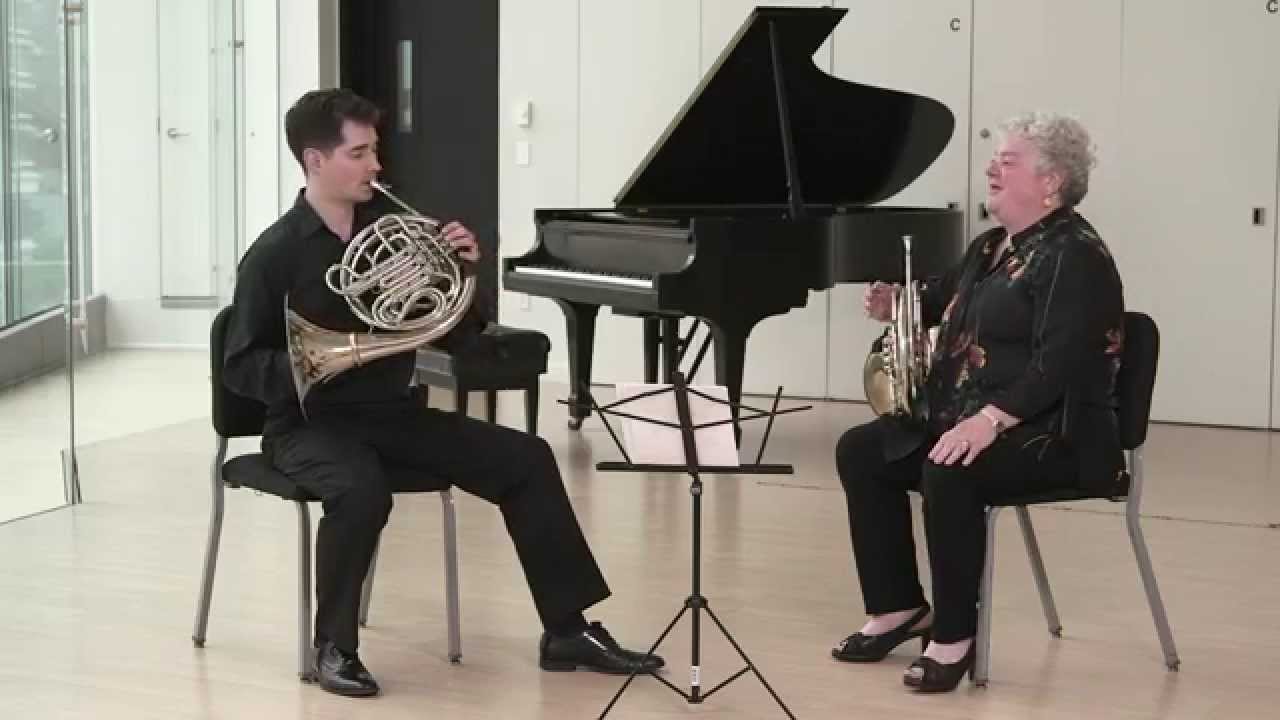After getting some feedback from my David Cooper article, I wanted to periodically put together some good resources to introduce influential horn players to a younger generation of players.
For this article, I’m going to focus on the former principal horn of the Metropolitan Opera for 25 years – Julie “JFL” Landsman.
Interviews
Even though things have (mostly) ground to a halt since March, Julie has been quite active in the horn (and music) world over the past few months.
She has given two great podcast interviews (on The Brass Junkies and Pathways) quite recently. They are both equal parts inspiring, educating, and hilarious. The origin of her nickname “JFL” (in the Pathways podcast) gives an example of both her sense of humor and love of her students.
If you want more, she also gave a wonderful interview in 2018 on the BulletproofMusician podcast. It’s less focused on brass and horn playing and more geared toward all musicians (especially brass players dealing with first notes or performance anxiety). She also did a written interview with BrassChicks.com that I’ve discussed before.
She’s also appeared on several of Sarah Willis’ Horn Hangouts. She’s done a solo appearance, and one with several of her former-students-turned-Met-Opera-colleagues.
The Caruso Method
One of the things she discusses in almost all of her appearances is one of her most influential teachers, Carmine Caruso.
In fact, when I was in graduate school I did a paper about “Carmine Caruso and Adopting His Method for Horn”. My teacher, Bruce Heim, was also a Caruso student. He knew Julie from Julliard and put me in touch with her. Even as a busy principal horn (this was back in 2006) she took my call and patiently answered all of my questions!
(Incidently, I was first introduced to Caruso studies when I was a graduate student with Bruce at the University of Louisville.)
If you’ve never heard of Carmine Caruso, he was a saxophone, violin, and piano player who had a knack for teaching the physiology of brass playing. He was, according to Julie, a “chops” teacher. One of his specialties was “fixing” successful players who were having major playing difficulties.
Caruso Resources
There is a book of the “Caruso Method“, but I’ve heard that it’s not the most accurate transcription of Caruso’s method (which would be adapted to each student). As a way to continue the legacy of Carmine and his exercises, Julie has put out a great series on her adaptation of the Caruso method. You can find the sheet music and links to the videos here. The videos are also available on YouTube.
While the sheet music is a great resource to have for reference, I highly recommend watching the videos before you begin any sort of intensive Caruso study. Not only do they feature great demonstrations by Julie and Alexander Kienle (now Assistant Principal/Utility with the Dallas Symphony) but Julie offers some great tips and thoughts that aren’t present on the sheet music.
Also, make sure to follow Julie’s Caruso Practice Calendar. The Caruso Method is a form of physical training, and doing too much, too soon can cause injury.
Done properly and in moderation, though, these are wonderful exercises to improve the ease and efficiency of horn playing. Tying the constant subdividing with simple (but not easy) exercises really develops a strong foundation for all sorts of playing. They have been a part of my daily routine for years.
Mental Toughness
One other thing she covers in all her interviews are the challenges she faced early in her career. She was (I believe) the first woman brass player in the Metropolitan Opera Orchestra, and she talks about how many of her section members were not overly thrilled to have a woman as principal horn. Her only defense against their “displeasure” was to outplay them – which she consistently did.
She discusses a lot of different aspects of her mental training approach and how she works on performing well under pressure. One of the most interesting ideas she talks about is how strong internal subdivision (which is a huge part of the Caruso exercises) can help with controlling nerves while performing.
Conn 8D
In her Pathways podcast interview, she also talks at some length about her love for the Conn 8D horn and it’s sound.
The Conn 8D used to be the horn that you played as a professional in most areas of the US. Over the past 50 years, though, Geyer-style horns have become more and more common in orchestras across the country.
However, the Conn 8D still has a few holdouts. The Cleveland Orchestra is still an all-8D section, and many of the studio musicians out in LA (that perform on big Hollywood soundtracks) predominately use 8Ds in their recording sessions. Julie Landsman, though, maybe one of the biggest single 8D advocates, and the way she talks about the horn’s sound is poetic.
If you’re not sure what a great 8D section can sound like, here’s an arrangement of Eric Whitacre’s Sleep played by an octet of 8Ds:


Leave a Reply